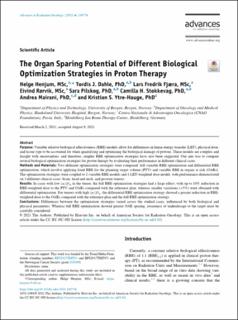| dc.contributor.author | Henjum, Helge | |
| dc.contributor.author | Dahle, Tordis Johnsen | |
| dc.contributor.author | Fjæra, Lars Fredrik | |
| dc.contributor.author | Rørvik, Eivind | |
| dc.contributor.author | Pilskog, Sara Margareta Cecilia | |
| dc.contributor.author | Stokkevåg, Camilla H. | |
| dc.contributor.author | Mairani, Andrea | |
| dc.contributor.author | Ytre-Hauge, Kristian Smeland | |
| dc.date.accessioned | 2022-02-17T07:54:22Z | |
| dc.date.available | 2022-02-17T07:54:22Z | |
| dc.date.created | 2021-12-03T12:30:56Z | |
| dc.date.issued | 2021 | |
| dc.identifier.issn | 2452-1094 | |
| dc.identifier.uri | https://hdl.handle.net/11250/2979525 | |
| dc.description.abstract | Purpose: Variable relative biological effectiveness (RBE) models allow for differences in linear energy transfer (LET), physical dose, and tissue type to be accounted for when quantifying and optimizing the biological damage of protons. These models are complex and fraught with uncertainties, and therefore, simpler RBE optimization strategies have also been suggested. Our aim was to compare several biological optimization strategies for proton therapy by evaluating their performance in different clinical cases.
Methods and Materials: Two different optimization strategies were compared: full variable RBE optimization and differential RBE optimization, which involve applying fixed RBE for the planning target volume (PTV) and variable RBE in organs at risk (OARs). The optimization strategies were coupled to 2 variable RBE models and 1 LET-weighted dose model, with performance demonstrated on 3 different clinical cases: brain, head and neck, and prostate tumors.
Results: In cases with low in the tumor, the full RBE optimization strategies had a large effect, with up to 10% reduction in RBE-weighted dose to the PTV and OARs compared with the reference plan, whereas smaller variations (<5%) were obtained with differential optimization. For tumors with high the differential RBE optimization strategy showed a greater reduction in RBE-weighted dose to the OARs compared with the reference plan and the full RBE optimization strategy.
Conclusions: Differences between the optimization strategies varied across the studied cases, influenced by both biological and physical parameters. Whereas full RBE optimization showed greater OAR sparing, awareness of underdosage to the target must be carefully considered. | en_US |
| dc.language.iso | eng | en_US |
| dc.publisher | Elsevier | en_US |
| dc.rights | Attribution-NonCommercial-NoDerivatives 4.0 Internasjonal | * |
| dc.rights.uri | http://creativecommons.org/licenses/by-nc-nd/4.0/deed.no | * |
| dc.title | The Organ Sparing Potential of Different Biological Optimization Strategies in Proton Therapy | en_US |
| dc.type | Journal article | en_US |
| dc.type | Peer reviewed | en_US |
| dc.description.version | publishedVersion | en_US |
| dc.rights.holder | Copyright 2021 The Authors | en_US |
| dc.source.articlenumber | 100776 | en_US |
| cristin.ispublished | true | |
| cristin.fulltext | original | |
| cristin.qualitycode | 1 | |
| dc.identifier.doi | 10.1016/j.adro.2021.100776 | |
| dc.identifier.cristin | 1964254 | |
| dc.source.journal | Advances in Radiation Oncology | en_US |
| dc.identifier.citation | Advances in Radiation Oncology. 2021, 6 (6), 100776. | en_US |
| dc.source.volume | 6 | en_US |
| dc.source.issue | 6 | en_US |

